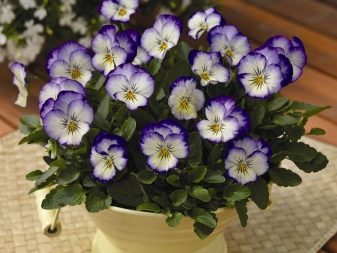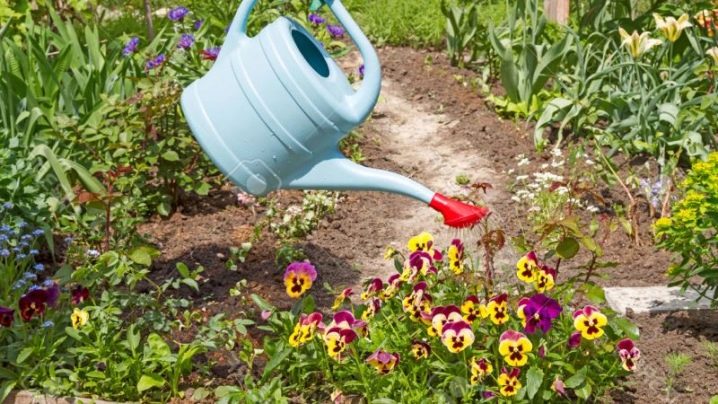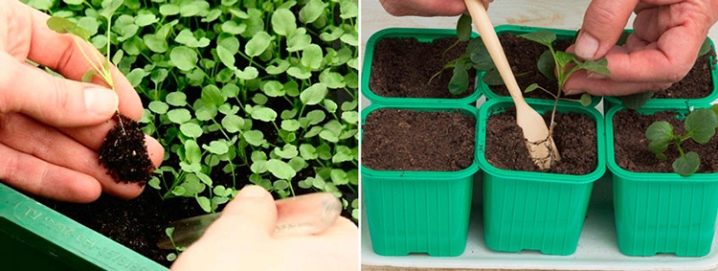Growing viola from seeds

Viola or violets (lat. Viola) is a whole detachment of wild flowers from the Violet family, numbering more than half a thousand different species that can be found around the world in countries with temperate and warm climates. Most of them are in Japan and North America, however, and this flower did not deprive Russia of attention. Thanks to the efforts of domestic and foreign breeders, the variety of viola varieties has increased significantly. In this article we will talk about how to grow viola from seeds ourselves.


Peculiarities
The main distinguishing feature of the viola is its unpretentiousness. It can be grown in the open air, although you still have to take great care of it. The most popular in our country are 3 types of viola: viola horned, viola Wittrock and viola Williams. Of course, these are not all types of violets that you can plant in your garden, and if you manage to find seeds of other frost-resistant varieties, you can purchase them, the rules of care will be approximately the same.



Another important difference between a viola is the way it blooms. Most violets bloom once a year, with one large flower blooming on a long stem. Violas bloom several times per season, the flowers and stems of the viola are much smaller, but about 5 buds can grow on one stem, which makes the flowerbed with them look much more voluminous. By the way, viola blooms only in the second year after planting. So don't be surprised not to see flowers after a couple of months.
Although gardeners still managed to find a way to make the plant bloom in a year, more on that later. Viola leaves can grow in different ways. Depending on its variety, they can either be located along the entire stem, or form a basal rosette.


Sowing dates
The most favorable time to plant violets will depend on the climate in your area. In most of Russia, they are planted in the spring, in mid-March, but if you live in a warmer region, then you can start planting in winter. Many gardeners plant viola in February, and some even in January. If, on the contrary, you live in a slightly colder climate, then you should wait until at least April to plant the planting to allow the earth to warm up.
For high-quality growth of young violets light is very important, it is worth considering this when planting, because if there is not enough light, then the sprouts will stretch out and, most likely, die. Many gardeners even recommend artificially extending daylight hours to 14 hours in the early stages of growing.
It is best to plant the viola in partial shade, for example, under a tree from which diffused light falls. If you plant it in a place where direct sunlight will fall on it, then the plant will quickly fade and wither.
You can plant a viola in the shade, it will still grow, but be prepared for the fact that the density of flowers on it will then be much less.

In general, it is permissible to sow viola in several terms. If unfavorable weather lasts for a long time, then planting seeds in May is quite acceptable. In this case, the flowers should bloom closer to August, and flowering can last until winter.
When choosing the optimal month for landing, it will be useful to seek help from the lunar calendar. Scientists have noticed for a long time that the growth of violets is very strongly influenced by the phases of the moon.By planting flowers at the right time, you can achieve faster growth and more lush bloom.

Preparation of soil and materials
Before planting viola seeds in open ground, you should prepare it. To get started, you need a special soil mixture, which you can either purchase from the store or make your own. To do this, you need to mix peat, humus, turf and leafy soil in equal proportions. To the finished mixture (it does not matter whether it is homemade or purchased), you need to add river sand in a ratio of 1: 8 and steam it well. Such soil is rich in nutrients, retains heat well and conducts water.
If your plot has fairly good soil, then the potting mix can simply be mixed with it and loosened well, and then plant the seeds. But if you have poor soil on the site, then it will be better to drip small holes for planting and fill them with a mixture. In addition, you will need a special seed stimulant to accelerate their growth, and small sawdust mulch, which you need to purchase in advance.
As for the choice of a landing site, it should be sunny, best of all in partial shade. Although the plant is quite calm and perceives darkened areas. The main thing is that in no case plant viols in the lowlands, otherwise they will simply be flooded.

Planting process
As mentioned earlier, viola usually blooms in the second year, but gardeners have found a way to make it bloom in the first year of life, or, conversely, you can grow a viola, which will bloom only after 2 years. If you want the flower to bloom in a few months, then you need to plant it with cuttings and grow it only at home. Cuttings are planted in the same potting mix, which will need to be distributed among the pots.
If you decide that it is better to plant the flower in the open field, then do not forget to prepare the planting site, and then follow the next instructions step by step.
- To begin with, the seeds need to be treated with fertilizer that accelerates growth.
- Then you need to prepare the potting mix and pour it into a large pot or cassette.
- In the soil, you need to make small grooves (half a centimeter deep), where we will place the seeds.
- From above, the seeds need to be sprinkled with earth (or better with a homemade mixture from the soil).
- Next, you need to properly water the plant so that the earth is completely shed, but without eroding the soil, otherwise the opened seeds will die.
- To retain moisture in the soil, you can mulch it with fine sawdust.
- After that, you need to put the seedlings in the sunny part of the house (preferably in partial shade) and watered the soil as it dries.
- After about 2-3 months, you will be able to start replanting seedlings in prepared soil, the optimal distance between them is 20 centimeters.
- Be sure to loosen the soil before planting.
- Viola should be planted along with a piece of earth covering its roots.
- The holes you have prepared should be large enough to accommodate the seedlings freely. It is very important to ensure that the roots do not bend during planting.
- After placing the sprouts in the holes, fill the voids with the rest of the potting mix and compact well with your hands.
- After that, the sprouts need to be watered abundantly.
- At the end, the planting is mulched with dried leaves, hay and needles.



This concludes the planting process. If you did everything correctly, then you will see the first flowers in a little more than a year. At the time of transplanting into the ground, certain varieties of viola may bloom, but do not worry, viola tolerates transplants very well, including during flowering. So you can transplant it on time, without worrying that it will somehow harm the flower.
Also, do not forget that after transplanting to a permanent place, the flowers need your care. Don't forget to water them in time, don't let them drown, with an excess of moisture in the soil, the roots of the viols begin to rot, which leads to the decay of the entire plant. Be sure to fertilize the plant on time. It is especially important to do this in the first years of his life. Do not forget that the soil in which the violet grows must conduct oxygen well, and therefore it needs to be loosened from time to time.
It is also very important mulch flowers for the winter, so that the soil retains heat better. Among other things, it is recommended to prune viola bushes once a year.
It is best to do this when it is still far from frost, but the plant has already completely faded. You need to cut it down to 4-5 centimeters. This procedure is very good for the next flowering.

Seedling care
In order for the viola bushes to be lush and healthy, it is very important to take care of the seedlings, since it is during this period that they need the most attention. You should not lock the seedlings in four walls, on a sunny day it will be useful to expose them to fresh air, this will not only have a beneficial effect on their growth, but also prepare them for further transplantation into the soil. After germination, it will be useful to cover the sprouts with a film to protect them from sunlight. It is not worth removing them in a dark corner, since a lack of light will negatively affect their growth.
Moreover, viola sprouts need at least 14 hours of daylight for stable growth. In Russia, such days are not always issued even in summer, let alone winter and early spring. Therefore, many gardeners recommend artificially lengthening daylight hours for seedlings using lamps that simulate sunlight.

When your seedlings have the first pair of leaves, they can be dived into separate cups. Viola tolerates transplantation well, even if in its process you accidentally damage the roots, there is nothing to worry about, this will only slightly slow down the growth of the flower, but it will not affect health. The diving of the sprouts will have a positive effect on their further growth.
When the sprouts have two more pairs of leaves, they can be pinned and dived into a larger container. This will increase their tillering. Be sure to monitor the water level in the plant's soil. Viola loves moisture very much, however, with its excess, its roots begin to rot, which can lead to the death of the plant. Be careful in this matter. Drying out will also not have the best effect on the sprouts. Frequent, but not abundant watering would be ideal.

Possible problems
In the process of viola growth, certain difficulties may await you, you must be able to solve them in time. The most common problem that gardeners face is the elongation of the viola sprouts in the first weeks after planting. Correcting this situation is quite simple. If your sprouts are elongated, you need to bury the sprout deeper during the dive. This will not only solve this problem, but also make the root system of your flower more powerful, since new roots in the viola appear over the entire area of the stem covered with soil.
Another problem plaguing viola is poor seed germination. There are several reasons why seeds may not germinate well: they may be old, you may have sprinkled them too tightly, or the soil you sprinkled them may be too heavy.
To increase the germination of seeds, it is recommended to plant them more densely, you can plant them later when they sprout.

Temperature is also an important factor for good seedling growth. The most favorable room temperature is considered, it can be higher, but in no case lower. Too low a temperature can lead to a slowdown in the development of shoots or even their death. And don't worry, the sprouts will get used to the lower temperatures over time, but this will need to be monitored first.
If you did everything right, then very soon your garden (or your house) will be decorated with beautiful viola flowers. Viola is probably the best choice for any gardener, they are unpretentious, but at the same time they look very aesthetically pleasing and bright. All that is required of you is to plant and care for the plants correctly.
You will learn more about growing viola from seeds in the following video.
































































































The comment was sent successfully.